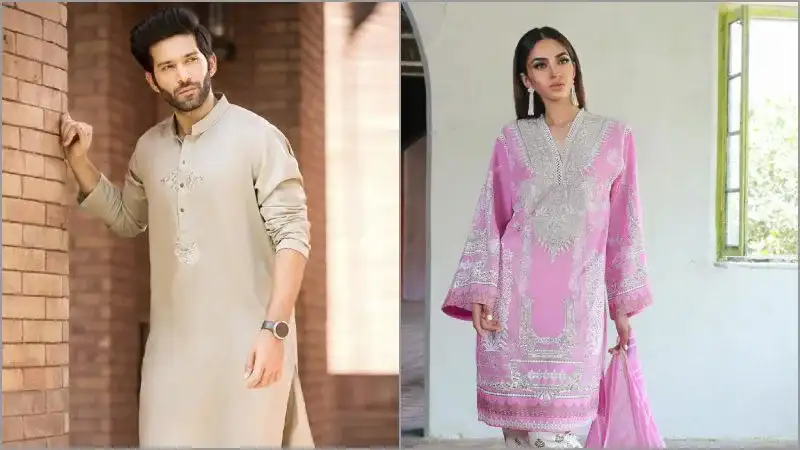The Pakistani kurta, a garment steeped in tradition and cultural significance, holds a special place in the hearts of people across the country. Its evolution over the centuries reflects not only changes in fashion but also shifts in societal norms and cultural preferences.
In this comprehensive exploration, we delve into the rich history, evolution, and enduring influence of the Pakistani kurta, unraveling its significance as more than just a piece of clothing but as a symbol of identity, tradition, and cultural pride.
Origins of the Kurta: A Journey Through Time
The origins of the kurta can be traced back to ancient times when it emerged as a practical garment suited for the diverse climate and cultural landscape of the Indian subcontinent. Early versions of the kurta were simple, loose-fitting tunics made from breathable fabrics such as cotton or silk, ideal for providing comfort in the sweltering heat of the region.
Over time, the kurta evolved to incorporate various influences, including Persian, Central Asian, and Mughal aesthetics, each contributing to its unique design and style.
Evolution of the Pakistani Kurta: From Tradition to Modernity
Traditional Styles and Silhouettes
In Pakistan, the kurta underwent various transformations, adapting to regional preferences and cultural sensibilities. In Punjab, for instance, the Punjabi kurta is characterized by its straight-cut silhouette, high collar, and side slits, often adorned with intricate embroidery or embellishments. Meanwhile, in Sindh, the Sindhi kurta features a more relaxed fit and is commonly paired with the ajrak, a traditional block-printed shawl.
Influence of Mughal Aesthetics
The Mughal era played a pivotal role in shaping the aesthetics of the Pakistani traditional dress. Mughal emperors were known for their love of luxury and opulence, and their influence can be seen in the elaborate designs, rich fabrics, and ornate embellishments that adorn many traditional kurtas. The Mughal kurta, characterized by its intricate embroidery and regal motifs, became a symbol of prestige and refinement.
Modern Interpretations
In contemporary Pakistan, the kurta has evolved to suit modern tastes and lifestyles. Designers have introduced innovative cuts, fabrics, and embellishments, blending traditional craftsmanship with contemporary aesthetics. The designer kurta has gained popularity, offering a wide range of options to suit every occasion, from casual outings to formal events. This fusion of tradition and modernity has ensured the kurta’s continued relevance in the ever-changing landscape of Pakistani fashion.
Cultural Significance of the Kurta: Beyond Clothing
Symbol of Identity and Tradition
The kurta holds deep cultural significance in Pakistan, serving as a symbol of identity, tradition, and cultural pride. People wear it on various occasions, including weddings, festivals, and religious ceremonies. Where it symbolizes respect, humility, and elegance. For many Pakistanis, wearing a kurta is not merely a sartorial choice but a way of honoring their heritage and connecting with their roots.
Gender Fluidity and Inclusivity
One of the most remarkable aspects of the kurta is its gender-neutral appeal. While traditionally associated with men’s clothing, the kurta has transcended gender boundaries to become a staple in women’s wardrobes as well. Women often pair the kurta with trousers or leggings, adding their unique twist to this timeless garment. This inclusivity and versatility have made the kurta a symbol of empowerment and self-expression for people of all genders in Pakistan.
Economic Empowerment and Sustainability
The production of kurtas provides livelihoods to thousands of artisans and craftsmen across Pakistan. Artisans handcraft many kurtas using traditional techniques such as hand embroidery, block printing, and weaving, supporting local communities and preserving centuries-old traditions. As the global demand for sustainable and ethically produced clothing grows, the Pakistani kurta has emerged as a symbol of eco-conscious fashion, promoting ethical practices and supporting artisanal craftsmanship.
Influence on Global Fashion: From Local Craft to International Runways
The Pakistani kurta has garnered international recognition for its timeless elegance and understated sophistication. It has inspired designers and fashion enthusiasts around the world, who admire its simplicity, versatility, and cultural significance. The rise of Pakistani fashion designers on the global stage has further propelled the popularity of the kurta, with celebrities and influencers often spotted wearing Pakistani traditional dress at red carpet-events and fashion shows.
Conclusion
In conclusion, the Pakistani kurta transcends its status as a mere garment to embody a rich tapestry of history, culture, and craftsmanship. Its evolution over the centuries reflects the resilience and adaptability of Pakistani society, while its enduring significance underscores its timeless appeal and cultural relevance. As Pakistan navigates the complexities of modernity while cherishing its traditions, the kurta remains a steadfast symbol of the country’s cultural heritage, identity, and pride. Whether worn on festive occasions or as everyday attire, the kurta serves as a tangible link to Pakistan’s rich cultural legacy, reminding us of the beauty and diversity of this vibrant nation.
